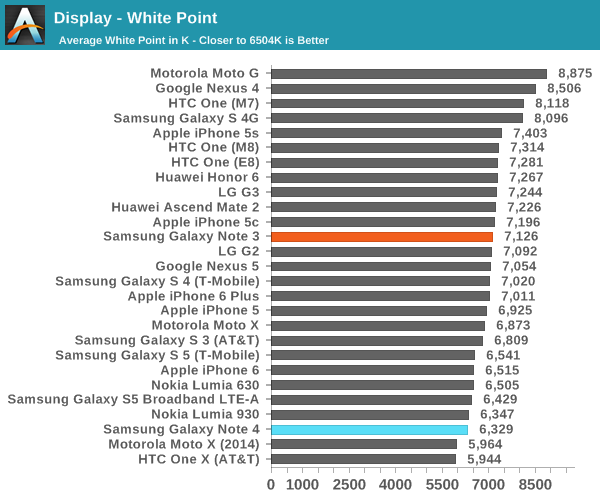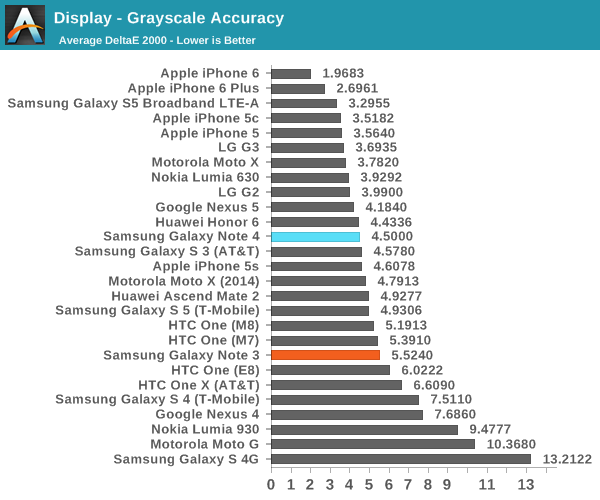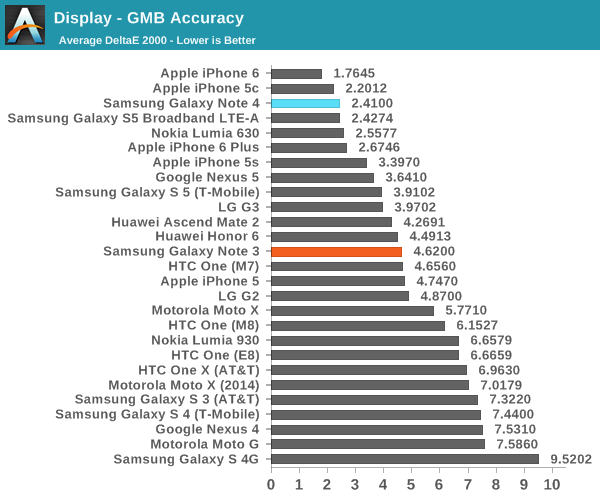The Samsung Galaxy Note 4 Review
by Joshua Ho on October 15, 2014 9:00 AM EST- Posted in
- Smartphones
- Samsung
- Android
- Mobile
- Galaxy Note 4
Display
With the advent of the modern smartphone, the display became one of the most important aspects of the entire experience as it was the only method of interacting with the device. To this end, Samsung has equipped the Galaxy Note 4 with their latest generation AMOLED panel, which has a higher resolution 1440p display, although this is achieved with a PenTile subpixel layout that makes total subpixel density lower than a conventional RGB stripe, so true subpixel density increases around 20% when compared to an RGB stripe 1080p panel. For reference, going from an RGB stripe 1080p panel to a 1440p panel of the same subpixel stripe would have a density increase closer to 80%.
In practice, the visible resolution varies somewhere between the “worst case” where the eye can see the true subpixel density and the best case where the display appears to be an RGB stripe 1440p display. If I look closely it’s still possible to see a fringing patterns in certain cases. Other than these minor cases, the Galaxy Note 4’s display has more than enough resolution for a smartphone use case. This is noticeably better than what I see with the iPhone 6 Plus, although in casual use it’s unlikely that these resolution differences will actually matter in most cases. I definitely think that there will be a visible difference for VR, although even the Galaxy Note 4’s display lacks sufficient resolution to have a “perfect” display in that scenario.
However, resolution is a relatively simple metric to look at. In order to better test the display we must look at other key metrics. In order to do this, we turn to SpectraCal’s CalMAN 5, along with a spectrophotometer for accurate color measurements.

While relatively simple, brightness and contrast are quite important as a display that’s dim or low in contrast will appear to be quite poor. In terms of brightness, we see that Samsung continues to maintain relatively high peak luminance, and a massive improvement when compared to previous generation AMOLED displays. While the normal peak brightness is a bit on the low side, as long as one uses auto-brightness the display’s “boost mode” will be able to activate and reach around 450 nits so in practice sunlight visibility should be more than acceptable. Contrast remains as incredible as it always is with AMOLED displays of this generation, although there still seems to be visible RC delay of some sort as there can be a purple trail effect when pixels transition from an unlit to lit state. I suspect this is mostly unavoidable, and is generally only visible at low brightness.


The next test we’ll look at is grayscale, which can suggest issues with overall tints in the display and issues with gamma. In this area, we see that the display is definitely quite good in overall gamma but unfortunately there’s a bit of a green tint here which causes a regression when compared to the Galaxy S5 LTE-A Broadband. This is really only visible on some certain percentages of gray but it would be an area where some improvement is needed.

While grayscale is one aspect of the display, it’s also important to look at color overall. One of the first tests for color is the saturation sweep, where the Note 4’s display performs admirably. At this point, there’s really not much to point out for improvement as the dE2000 average is low enough that one won’t notice any issues with color accuracy in Basic mode.

Similarly, the display does a fantastic job in the Gretag Macbeth ColorChecker. It should be possible to get a good idea of what a photo will look like on other displays and other similarly color-sensitive work on the Note 4. Samsung has also included other modes for those that want more vivid or otherwise more saturated color, which is of great benefit for those interested in such a color profile. The one potential issue here is that there is color shifting when altering viewing angles. In comparison to the Note 3, the Note 4 has a far better display. As-is, the state of AMOLED seems to be in a dead heat with LCD now as both seem to have their own trade-offs. However, we may soon see a shift as Samsung’s AMOLED becomes indisputably better than even the best LCDs.













195 Comments
View All Comments
MattL - Thursday, October 16, 2014 - link
Not strange at all, often certain places will get early review devices, they got an early iPhone 6 and 6+ too.Arcetnathon7 - Thursday, October 16, 2014 - link
Yes, but every early review of iPhone 6 and 6+ are "strangely" without any benchmarks.We always have to wait for Anandtech :)
MattL - Friday, October 17, 2014 - link
Well Display Mate had Note 4 and iPhone 6 Plus screen reviews up for a while now... I honestly would trust them more on the screen side of things anyways (they are far more comprehensive in their analysis and are obviously specialized experts in screens)... just curious as to the differences seen between theirs and the analysis here since they found the Note 4 definitely more accurate vs here.I do agree that you see very few iPhone 6 reviews with benchmarks though.
I would be very interested in other sites doing in-depth screen analysis runs, should give a better picture... but unfortunately not many sites do and the couple others I have seen are *horrible*, they didn't even realize that the Note 4's screen modes actually supported different color gamuts so they critiqued the color accuracy on the Adaptive mode specifically designed to have a high saturation of the color gamut to fend off ambient light washing out that saturation or the Photo mode which supports the Adobe RGB color gamut (17% larger than sRGB) do a high degree of accuracy, but when viewing non Adobe RGB content it will analyze off obviously. While the Basic mode is designed to be extremely color accurate to the sRGB standard (again Display Mate found it to be the most accurate of any smartphone or tablet screen, even the iPhone 6 screens)... so those sites results are pointless.
tralalalalalala40 - Saturday, October 18, 2014 - link
Does the user have to manually change the color scheme on the note4 for every app?tralalalalalala40 - Saturday, October 18, 2014 - link
The golden phone review, hand picked by robots maybe? At least they aren't programming their phones to cheat benchmarks anymore (most likely)trynberg - Wednesday, October 15, 2014 - link
So, the iPhone 6+ is declared the best phablet with no supporting statements or qualifications. The Note 4 gets "remains one of the best phablets on the market, but whether it's the best for a given user is a matter of priorities and personal preference rather than any absolutes".I mean, how blind do you have to be to not see the bias there?
KPOM - Wednesday, October 15, 2014 - link
This is actually a much more positive review of the Note 4 than ArsTechnica. AT basically said it comes down to your OS preference.MattL - Thursday, October 16, 2014 - link
Ars had the most negative Note 4 review I've seen anywhere on the web... really surprised about that, very disappointed.tralalalalalala40 - Saturday, October 18, 2014 - link
Go to samsung's website, they have a great review of the note 4 that should cheer you up.TrackSmart - Wednesday, October 15, 2014 - link
Thanks for the review! As always, this is much more complete information than you find at competing sites.That said, the Battery Charging Speed Test is not as useful as it could be. Supposedly this phone charges to 50% in the first 30 minutes. That means most of your testing time represents "topping off" the battery. Consider adding 50% or 75% charge speeds instead of (or in addition to) 100%. It would tell us which phones allow a user to quickly get back to business.